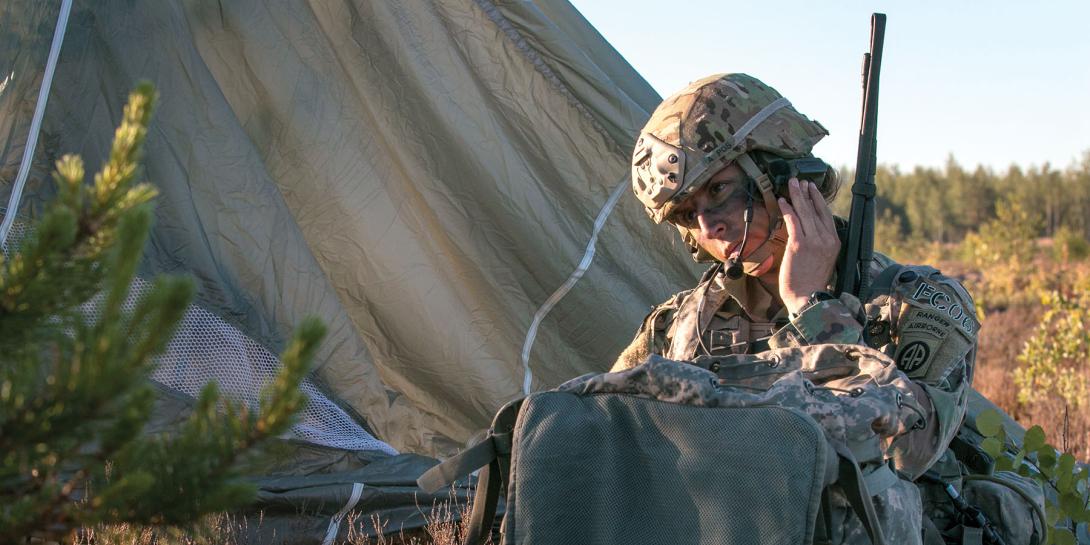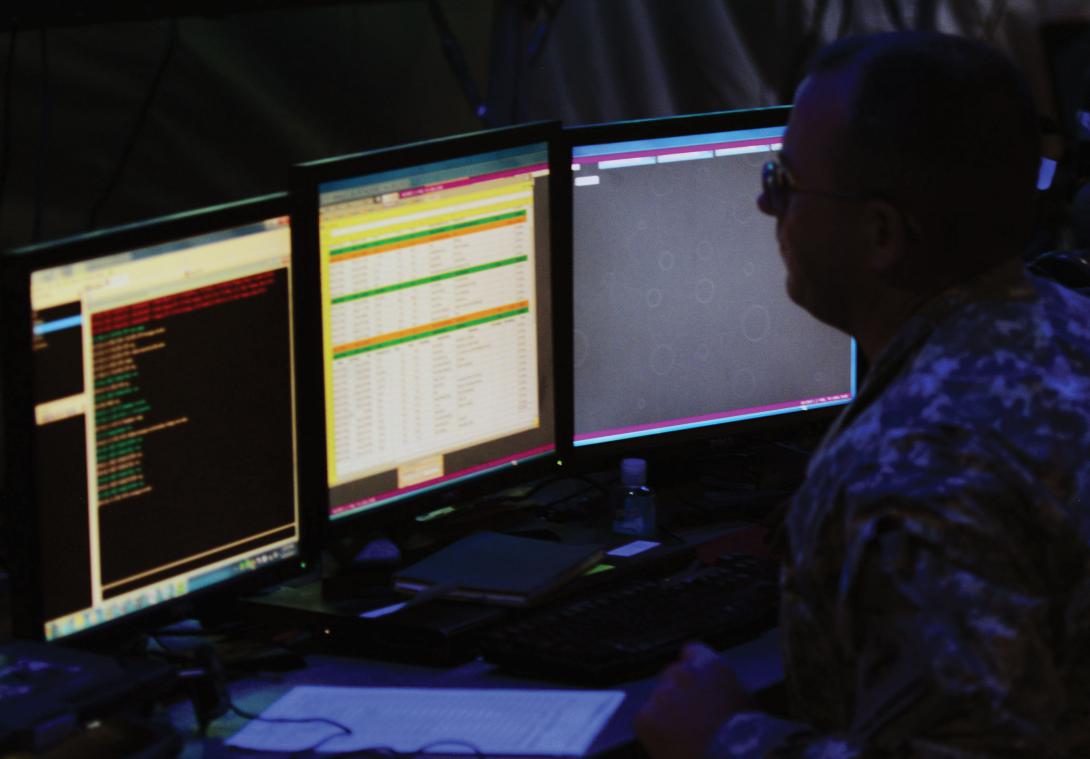Convergence Guides Army Cyber
The U.S. Army Cyber Command’s successful consolidation of capabilities from cyber, intelligence, electronic warfare and signal forces may be the deciding factor in whether sophisticated adversaries prevail in the future battlespace, says Lt. Gen. Stephen G. Fogarty, USA, leader of the command.
The general emphasizes that cyber is a weapon system, not a service. He states that Army cyber must operate, aggressively defend and modernize these principal weapon systems—both nonsecure and secret Army networks. Where some people would consider these networks a service or an administrative capability, Gen. Fogarty says he views them as core warfighting platforms or weapon systems. “We have to operate them, defend them and modernize them to keep pace with the requirements our combat commanders place on us and that our adversaries pose a threat to,” he states.
The general points out that all these activities focus on supporting active combat operations worldwide over a network that is secure, resilient and adaptive, allowing commanders to leverage the entire power of the U.S. Defense Department. And they must be carried out concurrently with operations. “For us, it is increasing our lethality and improving the readiness of the forces that are actually conducting operations,” he says.
Over the past 15 years in Southwest Asia, the force operated in a highly congested environment, the general continues. The commercial sector expanded rapidly, and military communications proliferated among the joint force and its foreign partners. The challenge was not adversaries preying on frequencies; instead, the force experienced a large amount of spectrum fratricide. “You had a multitude of actors operating in the space, and sometimes they stepped on each other,” he related. “And then you had just the normal day-to-day friction of establishing communications in very austere operating environments.”
The network was deployed with three basic operating principles in mind: capacity, speed of deployment and ubiquitous access, especially for partners. To meet those needs, the Army accepted a degree of risk in security and resiliency, Gen. Fogarty says.
But now, the service is transitioning from a congested operating environment to a contested operating environment, he explains. Many cyber adversaries also are employing electronic warfare (EW) activities ranging from jamming traditional communications systems to fouling radars and sensors, including GPS denial. “The congested factor is still there, but now you add on this layer of intentional disruption, and it’s a pretty sporty environment,” the general states.
“An adversary armed with an EW capability creates effect for our commanders,” he says. “They have to really work to understand the threat and understand what they have to do to operate effectively despite that threat.”
The Army must go beyond deconflicting to include synchronizing and integrating capabilities, Gen. Fogarty declares. These capabilities include intelligence, cyber and EW—which the Army has merged into cyber. “Much of what we’re doing on the cyber side, both defensively and offensively, depends on being able to understand what sensors are reporting,” he notes.
Integrating cyber and intelligence is an operational function rather than an organizational one, the general says. Cyber will continue to have a high level of dependency on the intelligence community. “Intelligence drives operations in the cyber domain, just as it drives operations in every other operational domain,” he states.
Cyber benefits from traditional intelligence as well as from information gleaned from everyday network operations, Gen. Fogarty imparts. The intelligence community is skilled at developing collection plans and determining where to place sensors, what they should detect and where they should report. Those who run the network must be equally adept at these tasks, he adds. Integration of information on enemy activity from the network and from conventional intelligence will be essential for success in the cyber domain, the general warrants.
Other activities being integrated include information operations, military information support operations and deception operations, and they are the next level to which the Army must progress rapidly. Participation in this endeavor by joint and foreign partners and the commercial sector is vital, he says.
“The future is here now. It’s all electronic warfare, both from understanding the environment, being able to identify enemy capabilities and being able to actively contest the enemy in this domain,” Gen. Fogarty says.
The Army’s own EW capability was built up quickly thanks to adversaries’ use of improvised explosive devices (IEDs) in Southwest Asia. Initially, the Army had to lean heavily on the U.S. Navy and Air Force until it could build its own organic capability, Gen. Fogarty relates. Enemy capabilities evolved as U.S. countermeasures advanced, and some U.S. commanders perceived previous IED threats as outmoded, resulting in a drawdown of U.S. EW capability.
But those commanders did not appreciate the advantages of U.S. spectrum dominance, Gen. Fogarty asserts. Adversaries did, and they built capabilities to attack U.S. spectrum. Russia, for example, actively employed EW in its Ukraine operations in conjunction with synchronized and integrated information-related capabilities. EW—operating in concert with intelligence analysis and collection, cyber capabilities and social media—generated a “pretty simple but effective” approach that allowed Russia to find, fix and finish its opponent, the general observes. By adding long-range precision fires to the mix, the Russian force became very lethal and effective, he adds.
Accordingly, the Army identified these trends as it began to develop the way ahead, Gen. Fogarty continues. After merging EW with cyber, the service set out to advance its electronic attack proficiency beyond the counter-IED capability. In this territory lie vital abilities such as defeating electronically fuzed munitions and disrupting Russia’s Global Navigation Satellite System (GLONASS), China’s Beidou navigation system or adversarial GPS use. “We have to maintain full-spectrum electronic attack capabilities—be able to sense the environment, classify the threat and provide countermeasures to protect our force,” he says. “At the same time, I want to be able to attack the enemy and deny their use of the spectrum and their information systems. I don’t want them to collect, to analyze and then decide and act.”
Army EW activity must be integrated with signals intelligence collection and communications planning, the general declares. This is essential to avoid a new form of spectrum fratricide. Saying he thinks the Army is on the right track, Gen. Fogarty states that the force can identify the threat and respond quickly, and it is delivering these capabilities to the field rapidly.
Staying ahead of adversaries also will take putting the right people in place. The Army Cyber Corps does not have an offensive military occupational specialty (MOS) or a defensive MOS. Network operations inform personnel how to defend the network and how the adversary operates—and, accordingly, how to attack that adversary. The same holds true for EW, the general offers.
The right people need the best technology possible too. Looking at the leap-ahead technology the Army requires to maintain a decisive lead over adversaries, Gen. Fogarty cites artificial intelligence, machine learning and quantum computing. He expects advances in those three disciplines to emerge from a combination of academic, commercial and defense research. Even foreign partners will play an important role in contributing technology in these areas, he adds.
The general notes Army Cyber Command’s high level of cooperation with foreign partners in both defensive and offensive cyber operations. “We are seeing operationally how we’ve learned a lot about processes and technical capabilities from the way they approach problems,” he allows.
Leap-ahead technology for the command could be an application, a tool or better cloud security, Gen. Fogarty continues. At the tactical level, the Army wants to exploit all these new capabilities to protect forces, defend networks and attack adversaries’ information technology.
The Army needs industry and academia to provide capabilities that can automate routine tasks, Gen. Fogarty says. Project Maven, for example, is designed to allow the workforce that performs processing, exploitation and dissemination (PED) for intelligence, surveillance and reconnaissance (ISR) to rapidly identify anomalous activity that could indicate adversarial action. This will be essential for both defensive and offensive cyberspace operations, he says, adding that the intelligence community has much to offer on how it is addressing the PED challenge.
The Army also needs other capabilities that allow it to act faster in the digital environment than an adversary, the general continues. “The need for speed is critical, as we’re watching adversaries become more adaptive. Whoever can sense, understand the other side and act faster than their adversary enjoys a decisive advantage,” he posits.
“We have a tendency to talk about velocity, variety and volume. But ultimately, what we’re seeing is an adversary who can move the fastest with the most precision—that’s who enjoys the decisive advantage,” Gen. Fogarty declares.
He offers that several activities provide the key to success in cyber operations. “First, we have to understand the environment,” the general affirms. “We have to be able to see the adversary and ourselves, and we have to do that simultaneously. For that, we have to identify the principal stakeholders and bring them together.
“This is a team sport, and to be successful in the cyber domain, we have to bring together the intelligence, cyber, signal, EW and information operations communities,” he continues. “And then, we have to link in very tightly with our maneuver and fires communities because, ultimately, this is what it’s all about.”
Instead of three different tools to plan operations in the frequency spectrum, Gen. Fogarty says he would like one tool the intelligence, signal and EW communities can use without inadvertently degrading mission command or intelligence collection—and do it on the fly, he adds. “At the end of the day, I must build a very integrated and synchronized team that is working to advise the commander … and provide very cogent recommendations for him to take action—protect his force and present the enemy with multiple dilemmas and ultimately win in this very complex operating environment,” the general says.







Comments